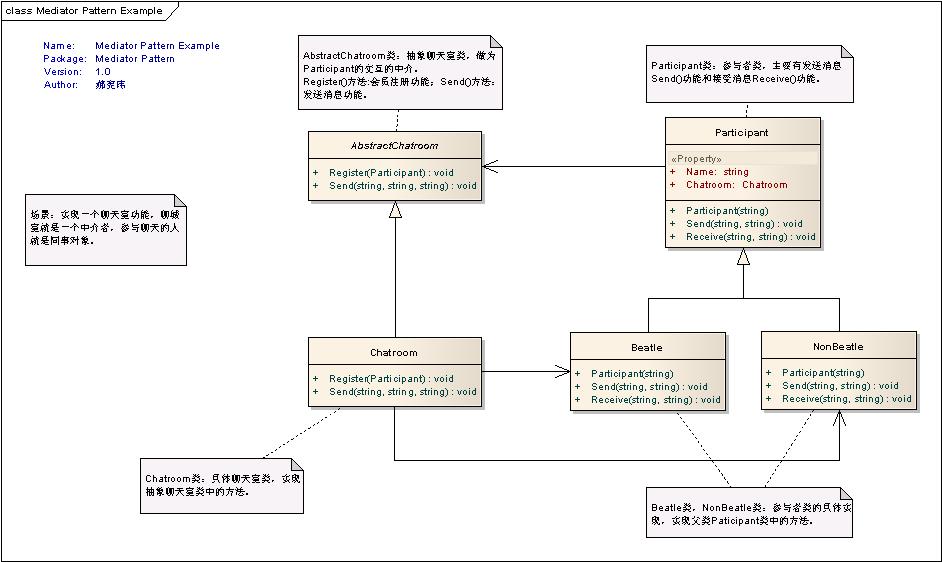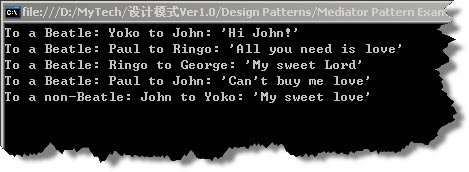中介者模式(Mediator Pattern)
2011-09-08 15:39
375 查看
Net设计模式实例之中介者模式(Mediator Pattern)
一、中介者模式简介(Brief Introduction)
中介者模式(Mediator Pattern),定义一个中介对象来封装系列对象之间的交互。中介者使各个对象不需要显示地相互引用,从而使其耦合性松散,而且可以独立地改变他们之间的交互。 Define an object that encapsulates how a set of objects interact. Mediator promotes loose coupling by keeping objects from referring to each other explicitly, and it lets you vary their interaction independently。中介者减少了各个同事对象的耦合,使得可以独立地改变和复用各个同事对象和中介者类;由于把对想如何协作进行了抽象,将中介作为一个独立的概念并将其封装在一个对象中,这样关注的对象就从对象各自本身的行为转移到他们之间的交互上来,也就是站在一个更宏伟的角度去考虑系统。
二、解决的问题(What To Solve)
中介者模式一般应用于一组对象以定义良好但是复杂的方法进行通信的场合,以及想定制一个分布在多个类中的行为,而不想生成太多的子类的场合。三、中介者模式分析(Analysis)
1、中介者模式结构

Mediator类:抽象中介者,定义了同事对象交互的接口。
ConcreteMediator类:具体中介者对象,实现抽象类中的方法,此具体中介者对象需要知道所有具体同事类,并从具体同事接受消息,向具体同事对象发送命令。
Colleague类:抽象同事类。
ConcreteColleague1类,ConcreteColleague2类:具体同事类,实现抽象同事类中的方法。每一个同时类需要知道中介者对象;每个具体同事类只需要了解自己的行为,而不需要了解其他同事类的情况。
2、源代码
| 1、中介者类Mediator及其具体实现类ConcreteMediator |
| /// <summary> /// The 'Mediator' abstract class /// </summary> abstract class Mediator { public abstract void Send(string message,Colleague colleague); } /// <summary> /// The 'ConcreteMediator' class /// </summary> class ConcreteMediator : Mediator { private ConcreteColleague1 _colleague1; private ConcreteColleague2 _colleague2; public ConcreteColleague1 Colleague1 { set { _colleague1 = value; } } public ConcreteColleague2 Colleague2 { set { _colleague2 = value; } } public override void Send(string message,Colleague colleague) { if (colleague == _colleague1) { _colleague2.Notify(message); } else { _colleague1.Notify(message); } } } |
| 2、抽象同事类Colleague及其实现类ConcreteColleague1、ConcreteColleague2 |
| /// <summary> /// The 'Colleague' abstract class /// </summary> abstract class Colleague { protected Mediator mediator; // Constructor public Colleague(Mediator mediator) { this.mediator = mediator; } } /// <summary> /// A 'ConcreteColleague' class /// </summary> class ConcreteColleague1 : Colleague { // Constructor public ConcreteColleague1(Mediator mediator) : base(mediator) { } public void Send(string message) { mediator.Send(message, this); } public void Notify(string message) { Console.WriteLine("Colleague1 gets message: "+ message); } } /// <summary> /// A 'ConcreteColleague' class /// </summary> class ConcreteColleague2 : Colleague { // Constructor public ConcreteColleague2(Mediator mediator) : base(mediator) { } public void Send(string message) { mediator.Send(message, this); } public void Notify(string message) { Console.WriteLine("Colleague2 gets message: "+ message); } } |
| 3、客户端代码 |
| static void Main(string[] args) { ConcreteMediator m = new ConcreteMediator(); ConcreteColleague1 c1 = new ConcreteColleague1(m); ConcreteColleague2 c2 = new ConcreteColleague2(m); m.Colleague1 = c1; m.Colleague2 = c2; c1.Send("How are you? JamesHao"); c2.Send("Fine, thanks"); // Wait for user Console.ReadKey(); } |
3、程序运行结果

四.中介者模式案例分析(Example)
1、场景
实现一个聊天室功能,聊城室就是一个中介者,参与聊天的人就是同事对象,如下图所示
AbstractChatroom类:抽象聊天室类,做为Participant的交互的中介。
Register()方法:会员注册功能;Send()方法:发送消息功能。
Chatroom类:具体聊天室类,实现抽象聊天室类中的方法。
Participant类:参与者类,主要有发送消息Send()功能和接受消息Receive()功能。
Beatle类,NonBeatle类:参与者类的具体实现,实现父类Paticipant类中的方法。
2、代码
| 1、抽象聊天室类AbstractChatroom及其具体聊天室Chatroom |
| /// <summary> /// The 'Mediator' abstract class /// </summary> abstract class AbstractChatroom { public abstract void Register(Participant participant); public abstract void Send(string from, string to, string message); } /// <summary> /// The 'ConcreteMediator' class /// </summary> class Chatroom : AbstractChatroom { private Dictionary<string, Participant> _participants =new Dictionary<string, Participant>(); public override void Register(Participant participant) { if (!_participants.ContainsValue(participant)) { _participants[participant.Name] = participant; } participant.Chatroom = this; } public override void Send(string from, string to, string message) { Participant participant = _participants[to]; if (participant != null) { participant.Receive(from, message); } } } |
| 2、参与者Participant类及其实现Beatle、NonBeatle |
| /// <summary> /// The 'AbstractColleague' class /// </summary> class Participant { private Chatroom _chatroom; private string _name; // Constructor public Participant(string name) { this._name = name; } // Gets participant name public string Name { get { return _name; } } // Gets chatroom public Chatroom Chatroom { set { _chatroom = value; } get { return _chatroom; } } // Sends message to given participant public void Send(string to, string message) { _chatroom.Send(_name, to, message); } // Receives message from given participant public virtual void Receive(string from, string message) { Console.WriteLine("{0} to {1}: '{2}'",from, Name, message); } } /// <summary> /// A 'ConcreteColleague' class /// </summary> class Beatle : Participant { // Constructor public Beatle(string name) : base(name) { } public override void Receive(string from, string message) { Console.Write("To a Beatle: "); base.Receive(from, message); } } /// <summary> /// A 'ConcreteColleague' class /// </summary> class NonBeatle : Participant { // Constructor public NonBeatle(string name) : base(name) { } public override void Receive(string from, string message) { Console.Write("To a non-Beatle: "); base.Receive(from, message); } } |
| 3、客户端代码 |
| static void Main(string[] args) { // Create chatroom Chatroom chatroom = new Chatroom(); // Create participants and register them Participant George = new Beatle("George"); Participant Paul = new Beatle("Paul"); Participant Ringo = new Beatle("Ringo"); Participant John = new Beatle("John"); Participant Yoko = new NonBeatle("Yoko"); chatroom.Register(George); chatroom.Register(Paul); chatroom.Register(Ringo); chatroom.Register(John); chatroom.Register(Yoko); // Chatting participants Yoko.Send("John", "Hi John!"); Paul.Send("Ringo", "All you need is love"); Ringo.Send("George", "My sweet Lord"); Paul.Send("John", "Can't buy me love"); John.Send("Yoko", "My sweet love"); // Wait for user Console.ReadKey(); } |
3、运行结果

五、总结(Summary)
中介者模式(Mediator Pattern),定义一个中介对象来封装系列对象之间的交互。中介者使各个对象不需要显示地相互引用,从而使其耦合性松散,而且可以独立地改变他们之间的交互。中介者模式一般应用于一组对象以定义良好但是复杂的方法进行通信的场合,以及想定制一个分布在多个类中的行为,而不想生成太多的子类的场合。相关文章推荐
- 二十四种设计模式:中介者模式(Mediator Pattern)
- 大话设计模式二十三章经(三) 中介者模式(Mediator Pattern)
- 中介者模式(Mediator Pattern)
- 23种设计模式(17)_行为型_中介者模式(Mediator Pattern)
- 协调多个对象之间的交互——中介者模式(Mediator Pattern)
- 深入浅出设计模式——中介者模式(Mediator Pattern)
- 中介者模式 Mediator Pattern
- 我所理解的设计模式(C++实现)——中介者模式(Mediator Pattern)
- 十一个行为型模式5:中介者模式-Mediator Pattern【学习难度:★★★☆☆,使用频率:★★☆☆☆】
- 中介者模式(Mediator Pattern)
- "围观"设计模式(25)--行为型之中介者模式(Mediator Pattern)
- 中介者模式(Mediator Pattern)
- 4.7 《硬啃设计模式》 第24章 麻烦的多角关系 - 中介者模式(Mediator Pattern)简介
- 4.7 《硬啃设计模式》 第24章 麻烦的多角关系 - 中介者模式(Mediator Pattern)简介
- Net设计模式实例之中介者模式(Mediator Pattern)(1) 推荐
- Net设计模式实例之中介者模式(Mediator Pattern)(2)
- 中介者模式(Mediator Pattern)
- Java中介者模式(Mediator Pattern)
- 中介者模式(Mediator Pattern)
- 我所理解的设计模式(C++实现)——中介者模式(Mediator Pattern)
